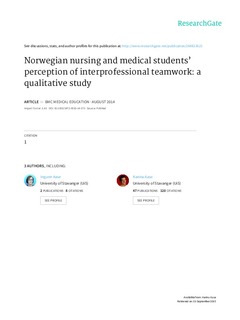| dc.contributor.author | Aase, Ingunn | |
| dc.contributor.author | Hansen, Britt Sætre | |
| dc.contributor.author | Aase, Karina | |
| dc.date.accessioned | 2015-09-01T12:21:48Z | |
| dc.date.available | 2015-09-01T12:21:48Z | |
| dc.date.issued | 2014 | |
| dc.identifier.citation | Aase et al. (2014): Norwegian nursing and medical students’ perception of interprofessional teamwork: a qualitative study. BMC Medical Education, 14:170. | |
| dc.identifier.uri | http://hdl.handle.net/11250/298366 | |
| dc.description | Originally published in BMC Medical education; http://www.biomedcentral.com/1472-6920/14/170/. | nb_NO |
| dc.description.abstract | Background: Little is known about the ways in which nursing and medical students perceive and understand their
roles in interprofessional teamwork. A 2010 report by the World Health Organization highlights the importance of
students’ understanding of teamwork in healthcare, and their ability to be effective team players. This study aims at
describing nursing and medical students’ perceptions of interprofessional teamwork, focusing on experiences and
recommendations that can be used to guide future educational efforts.
Methods: The study uses a qualitative research design. Data were collected from four focus group interviews: two
homogenous groups (one with medical students, one with nursing students) and two mixed groups (medical and
nursing students).
Results: The results show that traditional patterns of professional role perception still prevail and strongly influence
students’ professional attitudes about taking responsibility and sharing responsibility across disciplinary and
professional boundaries. It was found that many students had experienced group cultures detrimental to team
work. Focusing on clinical training, the study found a substantial variation in perception with regard to the different
arenas for interprofessional teamwork, ranging from arenas with collaborative learning to arenas characterized by
distrust, confrontation, disrespect and hierarchical structure.
Conclusions: This study underlines the importance of a stronger focus on interprofessional teamwork in health
care education, particularly in clinical training. The study results suggest that the daily rounds and pre-visit
“huddles,” or alternatively psychiatric wards, offer arenas suitable for interprofessional training, in keeping with
the students’ assessments and criteria proposed in previous studies. | nb_NO |
| dc.language.iso | eng | nb_NO |
| dc.publisher | BioMed Central | nb_NO |
| dc.subject | professional role | nb_NO |
| dc.subject | interprofessional education | nb_NO |
| dc.subject | interprofessional teamwork | nb_NO |
| dc.subject | content analysis | nb_NO |
| dc.subject | students’ perceptions | nb_NO |
| dc.subject | healthcare | nb_NO |
| dc.subject | helsepersonell | nb_NO |
| dc.title | Norwegian nursing and medical students’ perception of interprofessional teamwork: a qualitative study | nb_NO |
| dc.type | Journal article | nb_NO |
| dc.type | Peer reviewed | nb_NO |
| dc.subject.nsi | VDP::Medical disciplines: 700::Health sciences: 800::Health service and health administration research: 806 | nb_NO |
| dc.source.journal | BMC Medical Education | nb_NO |
| dc.identifier.doi | 10.1186/1472-6920-14-170 | |
